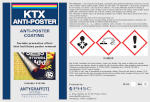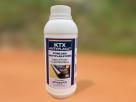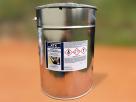Anti-poster coating
KTX anti-poster prevents various glues from penetrating into the protected surface. It causes stickers, labels, posters and tapes, regardless of the type of glue, to stick to the substrate very poorly. It makes it very easy to unstick the labels and posters, and there are no traces of glue remaining on the surface. Sometimes just rain is enough to cause the posters to come off. The anti-poster coating is perfect for protecting urban infrastructure: lamp posts, street lights at crossroads, electricity and telecommunication casings etc.
Product qualities:
- Very effectively prevents posters form permanent sticking
- Acts as a UV filter
- Preserves the surface and prolongs colour intensity
- Provides permanent protection against graffiti
- Applicable both in- and outdoors
- Make it possible to remove posters many times without repeated coating applications
- Does not damage the substrate
- Does not affect the look of the protected surface
- Prevents glues, water, grease, paints, oils from penetrating into the surface
- Available both in matte and glossy varieties
- Facilitates quick and easy cleaning of the protected surface (no aggressive cleaners are required)
- Application by means of brushes, rollers, spray.
Preparation description
KTX Anti-poster is a single component colourlessly drying preparation used for surface protection against anti-poster functionality with a strong anti-adhesive characteristics which renders is difficult on even impossible to stick posters, stickers and tapes with own adhesive layer. The preparation is fast-drying; it cures under the influence of air moisture and features very good adhesiveness. Treated surfaces are ideally protected against posters, stickers, glue, chewing gum, aerosol graffiti paints and most commercially available markers, ink, changeable weather conditions, bird droppings, dirt it also prevents water penetration and protects against hazardous substances. On its application, KTX Anti-poster constitutes an anti-corrosive release liner that prevents from penetrating substrates, reduces adhesiveness of paint coatings/pigments/adhesives and makes it easy to remove them from a coating surface. KTX Anti-poster is a diffusion-open preparation with preservative properties and UV filters, thanks to which it retains the colour of the protected surface. Texture of protected surfaces remains intact. The preparation is available in three variants: gloss, matte/semi-matte, RAL colour.
Technical Data After Application
Coating durability: up to 15 years. Graffiti removal: no less than 10 cycles. Dried coating thickness: approx. 160 μm, depending on surface type and roughness. Full anti-poster and anti-graffitii protection is achieved after 24 hours at the drying temperature 22°C. The coating features anti-adhesive, anti-poster and anti-graffiti properties. The preparation also functions as a water-repellent and anti corrosive layer and an elastomer with high formability, durability and resistance to adverse external factors: thermal, biological or chemical, UV radiation, alkali, corrosion, salt and ammonia solutions. KTX Anti-poster is a durable system facilitating multiple removals of graffiti paints, without the need for coating restoration after graffiti removal.
Areas of Application
KTX Anti-poster can be used to secure elements of Urban infrastructure such as city signaling pole, road signs, lanterns, benches, electric and telecommunications boxes, bus shelters, underground passages, stations. The coating is suitable for use on smooth, porous surface, absorptive or non-absorptive surfaces, such as some plastics, metals, powder paints, most painted surfaces, bricks, clinker, ceramic tiles, natural or artifical stones, plaster and concrete. Due to a large variety of substrates, it is recommended to carry out initial testing before application to check reaction of the preparation with a substrate, define adhesiveness, the change in substrate colour shade, etc.
Application Method
After opening the container, stir all of the preparation thoroughly for approx. one minute with a mixer. After stirring, the preparation is ready for application. Do not dilute. Stirring is particularly essential in the case of 'matte' coating variant due to the added matte factor, which has to be well mixed in the entire volume of the packaging. Close the container after pouring over an adequate amount of the preparation. Contact with air will spur a slow curing effect of the coating, increasing its viscosity. The preparation is usable for several months after opening the container, as long as it is tightly closed and stored properly. In the case of a prolonged coating application, the preparation must be mixed repeatedly every couple of hours. Depending on weather conditions, the average application time is 6 hours at 20°C should the coating be poured into a container/tray; however, after 30 minutes, a skinning effect may gradually appear on the surface; it must be removed before further application.
KTX Anti-poster coating application:
- MATTE variant: -5°C to +30°C,
- GLOSS variant: +10°C to +30°C,
- relative air humidity: up to 90%,
- the temperature of the substrate should be at least 3°C above the dew point temperature at that ambient temperature and humidity.
Amount of coating layers:
- the preparation should be applied in two layers.
The second layer should be applied approx. 3 hours after the first one has cured, at the drying temperature of 22°C. There are no time limits for application of the second layer or supplementary applications of the coating. In the case of a longer break between applications of the two layers, rinse the protected surface with water to remove dust and other atmospheric impurities.
Priming:
Anti-poster coatings in a permanent system and absorptive substrates may become darker and create the effect “wet concrete”. To improve the aesthetics of absorptive substrates, e.g., concrete, sandstone; architectural concrete use one or two layers of primer. PX 07 primer causes reduction of the anti-poster coating wear and prevents/minimizes the darkening effect of the protected surface. Protect primed substrate from rain until the coating is applied. KTX Anti-poster coating should be applied to the primed substrate after complete evaporation of water or dry the substrate, min. 1 hour. The substrates covered with paints and protective coatings are not primed. PX 07 primer application: 5°C to +30°C.
Drying time KTX Anti-poster at 22°C:
- after 1 hour: dust-dry,
- after 2 hours: touch-dry, externally cured, no fingerprints left when touched,
- after 3 hours: cured,
- after 8 hours: complete curing.
Suitable weather conditions must be maintained throughout the entire coating drying period. Coating application in lower temperatures prolongs the drying time. Protect from rain for at least 3 hours after application. The coating should be applied precisely in order to cover all irregularities and cracks within the material structure. Failure to do apply the preparation precisely may limit the effectiveness of the coating and cause problems while removing graffiti paints. On a rough or porous surface, a uniform and sufficiently thick protective layer must be obtained. Make sure that no excessive coating should be applied on smooth surfaces; if streaks occur, distribute them on the substrate with a roller before they dry. The preparation can be used in ventilated rooms.
Application:
- lint free paint rollers,
- pneumatic/airless spraying method, nozzle 12 to 18.
Removal of Posters and Adhesives
Applied posters, tapes, stickers fall off on their own under the impact of wind and rain or they can be removed easily by tearing them off manually. Adhesive residues remaining on the protected substrate and posters can be removed by hand or with a water jet high pressure cleaner at up to 50°C under the and pressure of up to 100 bar. The coating does not require restoration after removal of posters and adhesive residues. Intensive scrubbing of the coating may damage the protection. It is recommended to wash the coating from atmospheric and traffic pollutions every 12 months in order to maintain appropriate anti-poster parameters.
Graffiti Removal Technology
Sprinkle surface with water or chemical remover and use a brush or a cloth to remove graffiti. With larger surfaces or porous substrates, it is recommended to wash graffiti out with a water jet high pressure cleaner at 50°C and under the pressure of up to 100 bar;
the water jest must be moved evenly, without prolonged action in individual areas. The recommended and the fastest method is to use gel chemical remover and apply preparation coating onto graffiti; wait for up to 10 minutes, chafe graffiti with a soft-hair brush and rinse with pressurized water. The liquid KT 04 preparation or gel KT 04+ preparation are dedicated graffiti paint chemical removers for KTX Anti-poster coatings. Following graffiti removal there is no need for application of new coating because it is only the graffiti that has been removed and the protection layer is left intact. The coating may be damaged if the used water pressure exceeds 100 bar or a turbo system is applied — a rotating nozzle, narrow nozzle jet or when the lance washing end is too close to the cleaned surface. Intensive scrubbing of the coating may damage the protective layer or reduce the number of graffiti removal cycles.
Wear
The basic principle is to apply 2 layers of anti-poster coating.
Theoretical spread rate: 3 m²/L (333 ml/m²) to 10 m²/L (100 ml/m²).
Theoretical spread rate is an approximate value defining the extreme consumption figures, which differ depending on the type of the protected substrate.
Absorptive surfaces, without texture: 3 m²/L (333 ml/m²) to 6 m²/L (167 ml/m²) jointly for two layers e.g., sandstone, concrete.
Low absorptive surfaces, without texture: 7 m²/L (143 ml/m²) to 8 m²/L (125 ml/m²) jointly for two layers e.g., facade paint coatings.
Non-absorptive surfaces, smooth: till 9 m²/L (111 ml/m²) jointly for two layers, till 10 m²/L (100 ml/m²) one layer, only for anti-poster protection e.g.: steel, ceramics, granite, surfaces coated with powder paint coatings.
Practical spread rate: depends on individual cases and applications, including: conditions during application, methods of application, shape and roughness of protected surfaces, as well as substrate absorbability and application losses.
In order to increase the spread rate on absorptive surfaces, it is recommended to use a primer: PX 07: approx. 8,3 m²/L (120 ml/m²) jointly for two layers.
Examples removal of stickers and posters of the objects protected by KTX anti-poster






